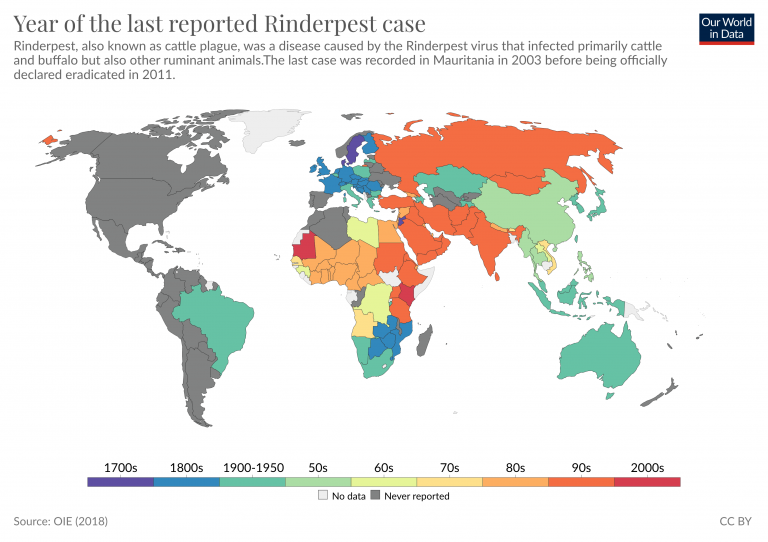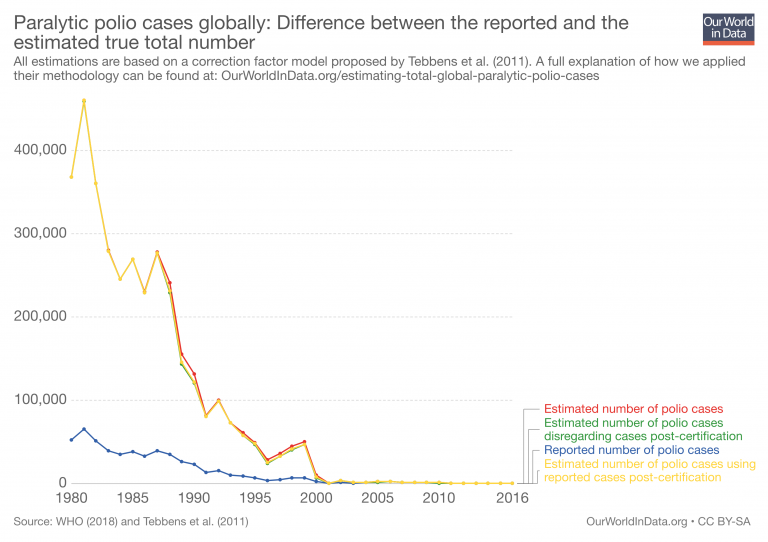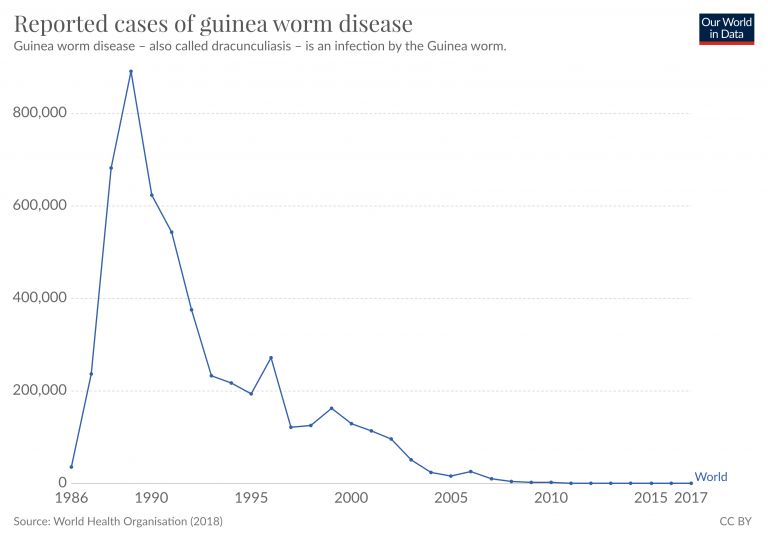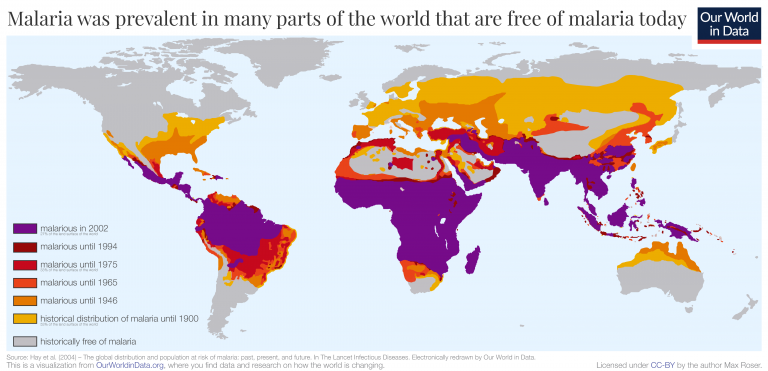Summary
The ultimate goal in the fight against diseases is their eradication. In theory, many diseases could be eradicated, in practice, only a handful of diseases meet the criteria that make them eradicable with current knowledge, institutions, and technology. In this entry we look at the progress the world has made in eradicating diseases, what makes a disease eradicable and which diseases we can hope to eradicate in the future.
- Diseases that are considered eradicable today are: polio, Guinea worm disease, lymphatic filariasis, cysticercosis, measles, mumps and rubella
- Eradicable diseases usually need to meet the following criteria: it’s an infectious disease, humans are the major host of for the disease, effective vaccines or treatments are available for the disease, and there is political and financial support for the eradication efforts
- The world has eradicated two diseases: Smallpox and Rinderpest
- Efforts to eradicate or eliminate additional diseases from parts of the world such as malaria, trachoma, river blindness and yaws are underway
All our charts on Eradication of Diseases
Related entries:
- Smallpox – How was smallpox eradicated?
- Polio – Just a generation ago polio paralyzed hundreds of thousands of children every year. Now the world can possibly eradicate it.
- Vaccination – Vaccines protect from diseases and are key to many eradication efforts.
Related writing:
“Eradication” versus “Elimination”
The eradication of a disease is permanent and global, while the elimination of a disease is an achievement restricted to a specific geographic area.
- Eradication of a disease refers to a deliberate effort that leads to the permanent reduction to zero of the worldwide incidence of infection caused by a specific agent.1
Eradication means that intervention measures are no longer required, the agent, which previously caused the disease is no longer present.
- Elimination of a disease refers to the deliberate effort that leads to the reduction to zero of the incidence of infection caused by a specific agent in a defined geographic area. A disease can be eliminated from a specific region without being eradicated globally. Actions to prevent the disease from transmitting or re-emerging are still required once a disease is eliminated.2
So far, the world has eradicated two diseases — smallpox and rinderpest. How many other diseases could we eradicate?
In this entry we are primarily guided by the list of eradicable diseases provided by The International Task Force for Disease Eradication (ITFDE). ITFDE was formed in 1988 at the The Carter Center; it is supported by the Bill & Melinda Gates Foundation and advises bodies such as the World Health Organisation on various aspects of disease eradication.3
The table here shows the two diseases which the world has eradicated and the seven diseases that ITFDE has listed as potentially eradicable.4 These diseases are — polio, Guinea worm disease, lymphatic filariasis, cysticercosis, measles, mumps and rubella. These diseases are considered eradicable diseases because they satisfy the criteria for disease eradication discussed below in this entry.
Which diseases can be eradicated and when it can be done is a topic of an ongoing discussion. The following examples illustrate the point:
While ITFDE has placed seven diseases on its eradicable diseases list, the WHO currently suggests that polio and Guinea worm disease are eradicable while lymphatic filariasis, cysticercosis, measles, mumps and rubella could be eliminated from some parts of the world.
Even for diseases where possibility of eradication has been agreed upon, the date when it will happen remains a moving target. The timeline for Guinea worm disease eradication was first set for 1991, then moved to 2009, then to 2015, then to 2020 and is currently set for 2030. 5
Global Malaria Eradication Program was established in 1955 to eradicate malaria, but it was abandoned in 1969. Today, however, a renewed focus on malaria eradication has emerged, with the Bill & Melinda Gates foundation proposing a plan to end malaria by 2040.6
All these examples illustrate that disease eradication is an ongoing process. As science discovers new facts about diseases and researchers invent new ways to tackle them the world has to change its perspective on which goals are feasible now and which ones are not yet.
Infectious diseases that have been eradicated and could be eradicated in the future7
Disease Burden of disease Cause Ways to eradicate Fatality
Smallpox Declared eradicated in 1980 Variola virus Eradicated using vaccination 30%
Rinderpest Declared eradicated in 2011 Rinderpest virus Sanitary measures and vaccination 100%
Poliomielitis 116 cases in 2017 Poliovirus Vaccination For paralytic polio 2-5% in children and increases to 15-30% in adults
Guinea worm disease 30 cases in 2017 Parasitic worm Dracunculus medinensis Hygiene, water decontamination and health education Not fatal but debilitating
Measles 173,457 reported cases to WHO in 2017 Measles morbillivirus Vaccination 15%
Mumps 560,622 reported cases to WHO in 2017 Mumps orthorubulavirus Vaccination 0.01% for mumps-caused encephalitis
Rubella 6,789 reported cases to WHO in 2017 Rubella virus Vaccination Not reported
Lymphatic filariasis No estimate available. In 2014, 68 million people were infected and 790 million people where at risk of infection Roundworms:
W. bancrofti,
B. malayi,
B. timori Preventive chemotherapy Not fatal but highly debilitating
Cysticercosis 2.56–8.30 million cases estimated by the WHO Tapeworms:
T. solium,
T. saginata,
T. asiatica Sanitation and health education. Vaccination of pigs Varies between countries <1-30%
| Disease | Burden of disease | Cause | Ways to eradicate | Fatality |
|---|---|---|---|---|
| Smallpox | Declared eradicated in 1980 | Variola virus | Eradicated using vaccination | 30% |
| Rinderpest | Declared eradicated in 2011 | Rinderpest virus | Sanitary measures and vaccination | 100% |
| Poliomielitis | 116 cases in 2017 | Poliovirus | Vaccination | For paralytic polio 2-5% in children and increases to 15-30% in adults |
| Guinea worm disease | 30 cases in 2017 | Parasitic worm Dracunculus medinensis | Hygiene, water decontamination and health education | Not fatal but debilitating |
| Measles | 173,457 reported cases to WHO in 2017 | Measles morbillivirus | Vaccination | 15% |
| Mumps | 560,622 reported cases to WHO in 2017 | Mumps orthorubulavirus | Vaccination | 0.01% for mumps-caused encephalitis |
| Rubella | 6,789 reported cases to WHO in 2017 | Rubella virus | Vaccination | Not reported |
| Lymphatic filariasis | No estimate available. In 2014, 68 million people were infected and 790 million people where at risk of infection | Roundworms: W. bancrofti, B. malayi, B. timori | Preventive chemotherapy | Not fatal but highly debilitating |
| Cysticercosis | 2.56–8.30 million cases estimated by the WHO | Tapeworms: T. solium, T. saginata, T. asiatica | Sanitation and health education. Vaccination of pigs | Varies between countries <1-30% |
Louis Pasteur once said that “it is within the power of man to eradicate infection from the earth”.8 That power has so far eradicated two infectious diseases: smallpox and rinderpest. We are also getting closer to eradicating polio and Guinea worm disease. But can we eradicate all infection from the world?
For a disease eradication to be feasible and an option worth considering it needs to meet certain criteria. Below we highlight some of these criteria. Notably, these criteria are not set in stone. Eradication of diseases is an ongoing process, as we learn more about diseases and find new ways to treat them we may find that some of these criteria become obsolete or that disease that were once considered not to fulfill any of these requirements begin to tick all the boxes.
Key requirements for disease eradication
There are several required aspects of a disease that need to be fulfilled in order for a disease to be considered eradicable:
- It needs to be and an infectious disease
- We need to have ways to either prevent or treat the infection
For a disease to be eradicable it needs to be a disease you can “catch” from other humans or animals, that is it has to be infectious. Non-infectious diseases, such as heart disease or cancer, cannot be eradicated.9
Without an effective treatment against a disease there is no possibility of eradicating it. The treatment can be either preventative, such as vaccination, or curative, such as drugs that can completely eliminate the pathogen that causes the disease from its host.
Disease aspects that make eradication more likely
In addition the the key requirements there are many other aspects of the disease that should be considered in the efforts to eradicate it:
- How many pathogens cause the disease?
- Does the disease-causing pathogen have one or more hosts?
- Are there any identifiable symptoms of the disease?
- Has regional disease elimination proven possible?
- Is the perceived disease burden high and is financial and political support available?
The more pathogens cause the disease the more difficult it will be to eradicate. If a disease is caused by a limited number and closely related pathogens then often same tools and approaches can be used in eradication efforts. For example, smallpox was caused by two types of variola virus and the same vaccine was used to prevent it. Contrast this to a disease such as pneumonia, which is caused by multiple pathogens– from bacteria to viruses – each of which requires a different treatment.
Diseases with multiple hosts are difficult to target for eradication because it often means that the disease will have to be eradicated in all of them.10 Pathogens, which cause diseases such as poliomielitis, measles, mumps, rubella, diphtheria and whooping cough, all have a single host — humans. But single-host pathogens are generally an exception rather than a rule. Case-in-point, the 2020 eradication target for Guinea worm disease had to be postponed, because we learned about high-rates of transmission of the Guinea worm between dog populations, which may be a source for new human infections.11
Some diseases are not easy to detect in the first place. 1.7 billion people live with latent tuberculosis infection today.12 Because latent TB has no symptoms, identifying every single individual that has latent TB infection, unless we test every person in the world, is not possible.
For other diseases even when symptoms may be visible or detectable, the stigma surrounding the disease may limit our ability to treat it. Hepatitis C is a disease that fits most eradication criteria, however, because the disease has a high prevalence among drug users, there is a stigma attached to being identified as an infected individual, making it difficult to identify all the cases.
Disease eradication is usually achieved one step at a time. A proof-of-concept eradication in one region is a positive indicator that eradication at a larger scale is possible. Once the disease elimination has been achieved on a smaller scale, a greater support for the feasibility of elimination elsewhere can be gathered.
The perceived burden of a disease, the estimated cost of eradication, and the political stability of affected countries are further factors that determine the eradicability of diseases. Polio is a good example here. Polio eradication efforts illustrate the powerful impact of both a unified international effort and a local political support.
In 1988, the Global Polio Eradication Initiative was set-up to provide a large-scale continued support for the eradication of polio. Since then, the number of paralytic polio cases has been greatly reduced such that in 2018 it was considered endemic in only three countries: Pakistan, Afghanistan, and Nigeria.
But polio also illustrates that positive developments might reverse. Nigeria’s case numbers surged from 202 in 2002 to 1,143 in 2006 because of rumors that polio vaccination was a covert affair to cause infertility and spread HIV in the local communities, which ultimately lead to an 11-month vaccination boycott.13 This example illustrates that eradication efforts have to span from international to national and community levels in order to be successful.
The immediate benefit of eradicating a disease is obvious — preventing suffering and saving people’s lives.
But eradicating a disease can also have significant economic benefits. Disease eradication takes years to achieve and requires a lot of financial investment: smallpox eradication had an estimated cost of $300 million over a 10-year period; polio eradication efforts to date amounted to $4.5 billion.14 But, as the chart here illustrates, while the initial costs of disease eradication efforts are high, in the long-term these costs pay-off. Simply controlling a disease can be more expensive because of the continued burden a disease poses on a healthcare system and the lost productivity of a sick population.
How much we should spend on eradicating a disease? There will always be other good causes we can spend money on. These include non-health causes, health causes with greater burden, eradication of different diseases, and even research into more cost effective treatments instead of eradication. The scenario or intervention which brings the highest benefit needs to be assessed for each disease separately.
As a classical paper by Walter R. Dowdle’s classical paper on disease eradication states: “Elimination and eradication are the ultimate goals of public health. The only question is whether these goals are to be achieved in the present or [by] some future generation”.15
Eradicating vs controlling a disease: schematic comparison of the costs
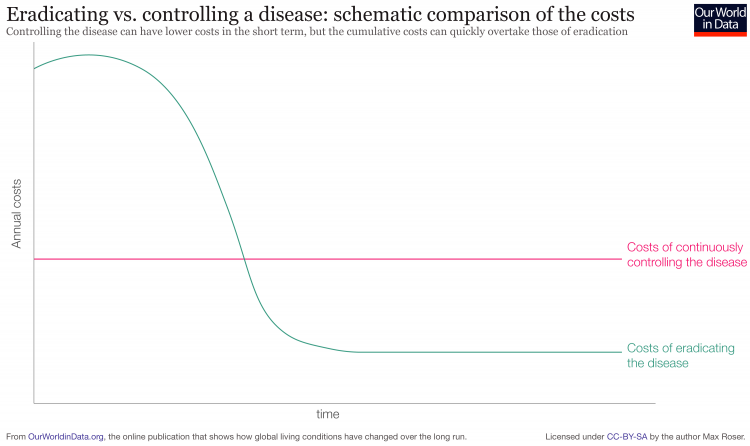
The world has successfuly eradicated two diseases:
- Smallpox was declared eradicated in 1980
- Rinderpest was declared eradicated in 2011
Smallpox: 200 years between vaccine and the disease eradication
The last recorded case of smallpox occurred in 1977 in Somalia. The disease was officially declared eradicated by the World Health Organization in 1980.
From the invention of vaccine against smallpox by Edward Jenner in 1796, it took almost two centuries to eradicate the disease.
It was only with the establishment of the World Health Organization in the aftermath of World War II that international quality standards for the production of smallpox vaccines were introduced and the fight against smallpox moved from national to an international agenda. In 1966, the WHO launched the Intensified Smallpox Eradication Program. By then smallpox cases and deaths in Europe and North America had been driven down substantially but large parts of Asia and Africa still struggled under smallpox’s disease burden.
Shown in the chart are the number of reported smallpox cases from 1920 until the last case in 1977. Even though smallpox had high visibility and should therefore have been relatively easy to document, the lack of an international organization dedicated to global health means the number of cases was likely much greater.
The world map illustrates the year the variola virus (the virus that caused smallpox) was no longer endemic in a country.16
Rinderpest: eradication began before vaccine against the disease was available
Rinderpest is the only animal disease that has been eradicated so far. Rinderpest outbreaks in cattles used to cause devastating losses for animal farmers. The eradication efforts began in the 1920s before the vaccine against the rinderpest virus was even available. Measures such as animal quarantine and slaughter were used to contain the disease.
The map here shows the last year in which cases of rinderpest were reported in a country. In 1960 an English veterinary scientist Walter Plowright has developed a vaccine against rinderpest, which finally led to its eradication.
You can read more about the history of rinderpest eradication in our post here.
Polio
Polio, short for poliomyelitis, is a disease that is caused by the poliovirus. Jonas Salk and Albert Sabin invented two polio vaccines in 1953 and 1961, respectively, which eliminated polio from the United States and Canada in 1979 and rapidly lead to a large reduction of the disease in the Western Europe. While Salk’s vaccine required injection with a needle, Sabin’s vaccine is oral and can be swallowed. The latter feature made its distribution throughout the developing world possible, as fewer trained healthcare staff were required for its administration.
The chart here highlights the global decline of the estimated number of paralytic polio cases from 1980 onwards. In the peak year 1981, the number of paralytic polio cases are estimated to have exceeded 450,000 but were reduced to 43 cases in 2016 – a more than 100,000-fold reduction of paralytic polio cases. As of 2019, wild polio virus is endemic in only three countries: Afghanistan, Nigeria, and Pakistan. In 2018, 9 countries have reported samples (human or environmental) positive for vaccine-derived poliovirus.
Guinea worm disease (dracunculiasis)
Guinea worm disease is caused by Dracunculus medinensis worm. There is no vaccine against the disease, however, it can be successfully eliminated by identification and treatment of all current cases of the disease.
In 2018, 28 cases of Guinea worm have been reported, these where in Angola (1 case), Chad (17 cases) and South Sudan (10 cases).17
Lymphatic filariasis
Lymphatic filariasis is a disease caused by roundworms. It is not a fatal but highly debilitating disease. It causes the swelling of lymph nodes, which in turn can cause painful swelling of arms, legs and other parts of the body.
In 2017 more than 62 million people lived with lymphatic filariasis. Majority of cases occur in Sub-Saharan Africa, South-Asia and Indonesia.
While the lymphatic filariasis-causing roundworms are transmitted by mosquitoes, the transmission can be effectively stopped by preventive chemotherapy. WHO and its partners have been working on mass drug administration campaigns (MDAs) to stop the transmission of the diseases. Rather than targeting just the infected individuals, MDAs target groups of people living in endemic areas.18Since 2000 7.7 billion treatments preventive chemotherapy have been administered via MDA campaigns.
Measles, mumps and rubella
Measles, mumps and rubella are three viral diseases that can be prevented by child vaccination.
The only known hosts of these viruses are humans, which makes it a good target for eradication. One of the major obstacles for eradicating these diseases is the misperception of the seriousness of the disease in the public, which leads to insufficient vaccination rates. Insufficient information on the disease prevalence and lacking means in developing countries are also important factors.
Combined, the World Health Organisation has registered more than 741,000 cases of these three diseases in 2017. This number is likely to be an underestimate since not all cases are reported to the WHO.
Measles is a highly contagious killer of young children globally, despite a safe and effective vaccine being available. In 2017 110,000 people died because of measles, the majority of whom were children younger than 5.19 The visualization here shows, the increase of the global vaccination coverage of one-year-olds and the simultaneous decline of reported cases of measles; from close to 1,000 cases per million people globally to 28 cases per million. This represents a 33-fold reduction.
Mumps infection occurs via direct human contact or by airborne droplets. It causes painful swelling at the side of the face under the ears (the parotid glands), fever, headache and muscle aches. It can cause sterility in teenagers and adults.
Rubella is usually mild in children but up to 90% of infections during pregnancy can result in complications and in approximately 20% of those cases result in fetal death.
Cysticercosis
Cysticercosis is a parasitic tissue infection of tissues (including brain and muscle tissue) caused by larval cysts of the pork tapeworm (Taenia solium). In low income countries these infections are a major cause of adult onset seizures. More information on the disease can be found on the website of the CDC here.
The International Task Force for Disease Eradication has put cysticercosis on a list of eradicable diseases back in 1993. However, the disease still affects millions of people globally. WHO estimates that 2.56–8.30 million people had neurocysticercosis in 2015.20 The disease is caused by tapeworms, which can affect the nervous system and cause severe epileptic seizures.
The map here shows the estimated rate of prevalence of cysticercosis. As is shown, the disease is most prevalent in Mexico and countries in South America, and Sub-Saharan and Southern Africa.
Eradication of cysticercosis in humans relies on the ability to break the tapeworm transmission cycle between humans and pigs. This can effectively be done through sanitary measures and proper inspection and cooking of pork. Furthermore, vaccines against the tapeworm are now available for the use in pigs, and oxfendazole drug can be used to remove the tapeworm from animals.21
The process of disease eradication is always ongoing. As new treatments become available and as we start to better understand the disease ecology new avenues open for the eradication of diseases.
There is no one defined path for disease eradication. Eradication is usually the final goal, and control of disease spread or local disease elimination is usually a more near-future goal for most diseases.
On the list of diseases that could potentially be eliminated in parts of the world are yaws, malaria, and trachoma.
Yaws
Yaws is a disease caused by the bacterium Treponema pallidum. The disease results in painful skin lesions, which can extend to damage in bones and cartilage. The disease is rarely fatal, however highly debilitating. Humans are the only known hosts for the bacterium that causes yaws and infections can be successfully treated by a single dose of antibiotic azithromycin. These factors make the disease a good target for eradication.
The exact burden of the disease is not known, primarily because of the lack of a global monitoring system for the disease. The world map visualizes the data that is available – a country’s status of endemicity in 2016 and the number of cases for countries that reported yaws infections to the WHO. Fourteen countries are known to be endemic for the disease. Many other countries, which were previously endemic, don’t monitor the disease and their status is therefore unknown, these countries are shown in yellow on the map.
Thanks to determined mass treatment and monitoring, India and Ecuador have eliminated yaws. They are colored green in the map.
Endemic countries are depicted in red or orange in the map, depending on whether the country reported the number of yaws cases to the WHO. When hovering over the countries shown in red the number of cases will appear.
On Our World in Data Sophie Ochmann and Hannah Behrens discuss the prospects for eradicating yaws in Can we eradicate yaws?.
Trachoma
Trachoma is a disease caused by the bacterium Chlamydia trachomatis. The disease affects eyes and causes blindness.
The map shows the global prevalence of trachoma. Limited information is available on the surveillance of the disease. The WHO states that 1.9 million people live with trachoma-caused blindness, and 142 million people are at risk of infection.22
Trachoma can be prevented by sanitary measures such as access to clean water and facial cleanliness. Mass administration of antibiotics can successfully stop disease transmission and surgery can reverse blindness caused by the disease.
Onchocerciasis
Onchocerciasis, also called river blindness, is an eye infection caused by a parasitic worm. The disease leads to blindness, skin damage and sometimes epilepsy.
The Global Burden of Disease study has estimated that the prevalence of river blindness was 20.9 million in 2017; 1.2 million of these cases resulted in blindness, 14.7 related in skin lesions and 5 million were asymptomatic.23 Prevalence of onchocerciasis is shown in the map.
Recent evidence suggests that mass drug administration with coverage of at least 80% can stop disease transmission.24
Malaria
The Institute of Health Metrics and Evaluation (IHME) provides estimates of malaria deaths from the year 1990 onwards. Over this period we see a clear rise-peak-fall trend, increasing from around 670,000 deaths in 1990; peaking at around 930,000 in 2004; and then declining (although at varying rates) to around 620,000 in 2017.
The Bill & Melinda Gates foundation proposed a plan to end malaria by 2040.25 The eradication plan largely relies on the development of new ways to prevent and treat the disease, such as effective vaccines, longer-lasting bed-nets and parasite resistance management programs.26 It is estimated that an increase in funding (at least a doubling of funding between 2015 and 2025 to annual costs of $6 billion) is also required.
- Description: A good summary of the methods available to eradicate Guinea worm disease, polio, malaria, lymphatic filariasis and river blindness. Figure 1 of the paper is especially helpful as an illustrated summary.
- Date of publication: 3 January 2013
- Available at: http://www.nejm.org/doi/full/10.1056/NEJMra1200391
- Description: This web publication is published by The College of Physicians of Philadelphia and describes disease eradication in general, but also discusses specific vaccine-preventable diseases (found in the table of content on the left) in an accessible and interactive way.
- Date of publication: Last updated 25 January 2018
- Available at: https://www.historyofvaccines.org/content/articles/disease-eradication
- Description: This article discusses how vector-borne diseases, specifically with insects like malaria, can be controlled, eliminated or even eradicated.
- Date of publication: 24 November 2017
- Available at: http://science.sciencemag.org/content/358/6366/998
We provide all data sources for this entry on a separate page.

